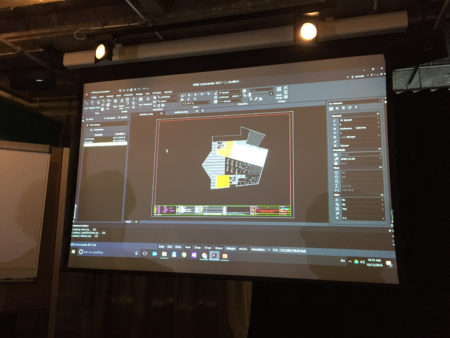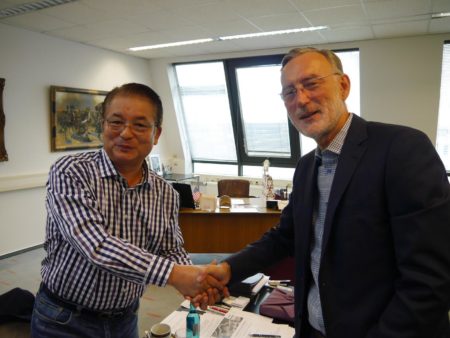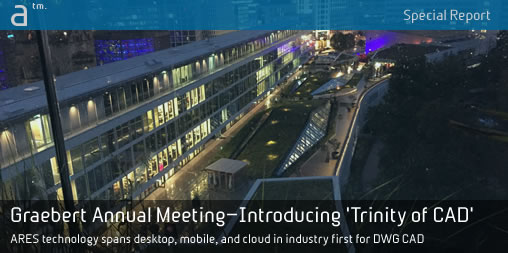Once again I attended the Graebert Annual Meeting in Berlin, and this marks the third year Architosh has participated as part of a small CAD press corps. Like in previous years, the two-day event focused on a series of technology keynotes covering not only Graebert’s DWG CAD technology but also the software offerings from other third-party developers who are licensees of that technology.
We highlighted last year why this event is important to follow but it bears repeating again and it goes something like this: DWG is far from dead.
DWG isn’t just far from dead, it is evolving under non-Autodesk hands (and not just Graebert’s) in a way that is beginning to feel disruptive. But the innovative potential of the most famous (mostly) 2D CAD format isn’t guaranteed and much of it seems to depend on a careful reading of the tea leaves at events just like this one.
A Focus on Core Technology
Part of the reason why DWG’s disruptive potential isn’t guaranteed is because Graebert itself isn’t particularly interested in being disruptive itself but rather interested in growing out its licenses and OEM base. On some real level, Graebert would rather focus on providing the core technology to other companies who can choose to do the riskier disruptive work—like the folks at Onshape.

01 – Graebert’s core technology is its ARES Commander CAD platform, a native DWG, 2/3D CAD platform capable of competing with Autodesk’s AutoCAD. This view shows the new ‘Trinity’ dark theme UI which will unify customer experiences across desktop, mobile and cloud. The new UI work isn’t just in color; new palette technology streamlines operations and makes better use of screen real estate.
Onshape—which was at the event this year as well—provided its most compelling pitch deck in a series of slides that focused on today’s market demands for ‘Agile’ workflows. The argument was highly convincing, focused on time-to-market pressures and the not-always-obvious advantages of true collaborative workflows.
For Graebert the mission seems quite clear: develop the best DWG CAD platform technology and make it available on every platform and major mobile device. Then, aggressively license this technology in a highly flexible manner to software OEMs (original equipment manufacturers) and seek out blue ocean markets.
A Focus on Global Expansion
Part of Graebert’s growth story is geographical expansion and that began years ago. A core expansion domain is in Japan, where an OEM (original equipment manufacturer) in JDraf Co. Ltd. has met with remarkable success. So strong has been their acceleration that Graebert partnered with its parent company, Computer System Technology Co., to take a 50 percent participation in the company. (see image 02) This is an interesting acquisition and it is unclear if CST will eventually allow the German CAD company to acquire more than half of its promising subsidiary. That question is really not significant at this point in time. What is important is that from this point forward the partnership will be known as Graebert Japan and will continue to seek market share growth against Autodesk’s AutoCAD, the DWG leader in Japan. This means the ARES branded CAD platform will be instantly applied to the Japan CAD market and aims to take leadership away from US-based Autodesk.
How does Graebert Japan see that happening?
There are a couple of factors at play advantaging ARES Commander in the Japanese CAD market. One factor is the availability of a full-fledged DWG CAD system on mobile platforms, particularly iOS but Android is also covered. Another factor is a superior licensing model that gives companies flexibility. Both ‘perpetual’ and ‘subscription’ licensing options exist and Graebert’s licensing kit just keeps getting better and better every year. In fact, Graebert’s new licensing system may, in fact, be the best licensing system we have ever seen by any company in the CAD or 3D market. Yet, let’s forget about how good and flexible it really is. The big thing is Japanese companies, according to conversations with Yoshiyuki Nagao and his colleagues during the event, do not want to be forced into the subscription-only licensing models that Autodesk is pushing forward with.

02 – Wilfried Graebert, CEO of Graebert shaking hands with Yoshiyuki Nagao, Chairman of the Board of JDraf parent company Computer Systems Technology Co. (CST) regarding their new partnership in Graebert Japan.
Finally, another factor that advances Graebert is simply its price advantage, offering a native DWG CAD system that goes more or less head-to-head with full AutoCAD for the price of AutoCAD LT.
These advantages are currently working in a very mature CAD market. CST of Japan (JDraf’s parent company) quite easily broke into three of the top five largest construction firms, unseating rivals. Now Graebert hopes to take a similar formula to other high-growth, high-opportunity markets. One such market is India but Brazil is another opportunity for the company and its OEM partners.
The other big question for expansion is the US market. While the company acknowledges going up against AutoCAD in the US is extremely challenging, the global number one market for CAD is rich with opportunity if Graebert can unseat AutoCAD LT licenses in particular. For the same price as AutoCAD LT, Graebert’s ARES solutions are offering quite a bit more, especially with the new Trinity technologies.
The Big News—The “Trinity of CAD”
Graebert’s announcement that it was offering the first DWG CAD solution that worked across desktop, mobile, and cloud—or what it calls the ‘Trinity of CAD’—is striking on two major fronts. The first is the ambition to have a single user experience that is tied together by is new licensing technology. A single license gives the user access to all three access platforms (desktop, mobile device or cloud) across various operating systems and on multiple computers.

03 – ARES Kudo is the center heart component of Graebert’s Trinity strategy, offering more agility for DWG workflows via the cloud. Combined with new licensing technology, your drawings always travel with you—just log in. Here is ARES Kudo running on an Apple MacBook laptop computer. Since ARES Kudo runs via a web browser, you can theoretically access it on an iPad as well.
This means a user can have a system at work (desktop Windows for example), a system at home (iMac for example), an iPad for mobile work, and still also access their work with ARES Kudo from any browser (say Chrome for Linux on the factory floor). When a user wants to move their license over to another machine, they simply log out of the ARES Licensing portal through a browser. Then they log-in on another machine they want to use to activate the license on that machine.
While the licensing technologies are a thing of beauty so too is the direction with the unified UI/UX treatment across all three access platforms (desktop, mobile, cloud). The admiration of the ‘dark’ UI on the ARES Kudo cloud app last year was something we had shared with the company and even suggested it would be nice to see it on the desktop, a la, the dark theme on the Mac version of AutoCAD. So it was nice to see this new dark color scheme being used to “harmonize the look and feel of the three products,” as Graebert put it during talks.
Not everyone likes the dark UI theme, however. Many veteran DWG CAD users prefer the lighter UI themes so Graebert is offering users the choice with ARES Commander. That’s fine but bear in mind on the mobile apps the dark theme has a purpose: it cuts down on battery consumption as darkening the screen always helps you preserve your energy use with mobile devices. From this perspective, one can say that the ‘Trinity’ themed dark UI is much more a reflection of contemporary computing culture, where users’ lives are predominantly oriented towards mobile devices and the cloud.
Additionally, OEM’s too have the choice to adopt or not adopt the Trinity dark UI theme. In fact, with ARES Kudo in particular, both OEMs and enterprise-scale users have the choice to “skin the app” and much more (we will delve deeper into ARES Kudo in another article).
To recap the point of Trinity is to converge three distinct solutions into a coherent, unified user experience applied to the single user or the enterprise customer. ARES Commander 2017 forms the heart of the desktop strategy, where the heaviest CAD loads are undertaken, on Windows, macOS, or Linux operating systems. ARES Touch 2017 is the mobile device solution and is capable of not just viewing, annotating, measuring and editing DWG files but actually creating them too. For most users, ‘field-based’ uses will prevail. ARES Kudo is the cloud solution and focuses on sharing and collaboration in addition to viewing and editing of DWG CAD files. In many ways, ARES Kudo has the chance to develop into something bigger than itself—major collaboration platform. (more on that later).
We will cover more details on all three of these ARES 2017 products in separate reports, but for now, let’s recap on some of the OEM highlights as well.
next page: Graebert Partners Advance Their Solutions




Reader Comments
RT @architosh: Graebert Annual Meeting 2016—Introducing ‘Trinity’ of CAD: Once again I attended the Graebert Annual Meeti… https://t.co/K…
RT @architosh: Graebert Annual Meeting 2016—Introducing ‘Trinity’ of CAD: Once again I attended the Graebert Annual Meeti… https://t.co/K…
[…] next page: Graebert Partners Advance Their Solutions […]
#Graebert Annual Meeting 2016 – Introducing ‘Trinity’ of CAD https://t.co/tgBicqLigm by Anthony Frausto-Robledo #cad
#Graebert Annual Meeting 2016 – Introducing ‘Trinity’ of CAD https://t.co/tgBicqLigm by Anthony Frausto-Robledo #cad
[…] Read the full article on Architosh. […]
Comments are closed.